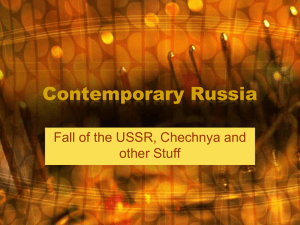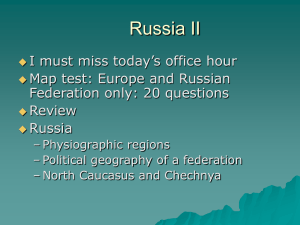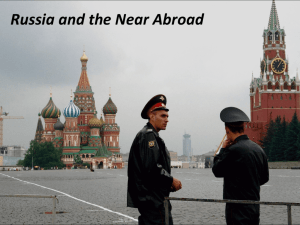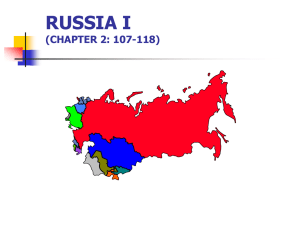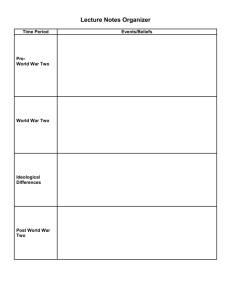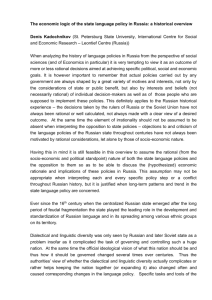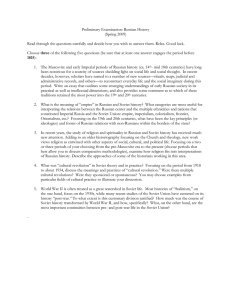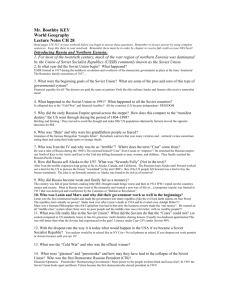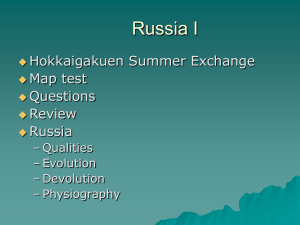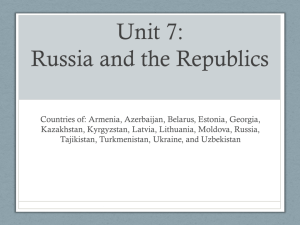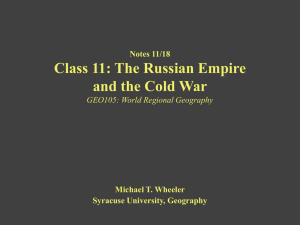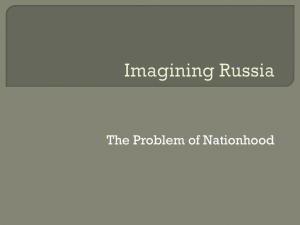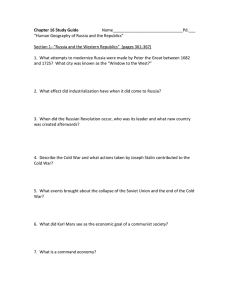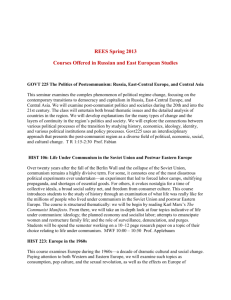RUSSIA
advertisement
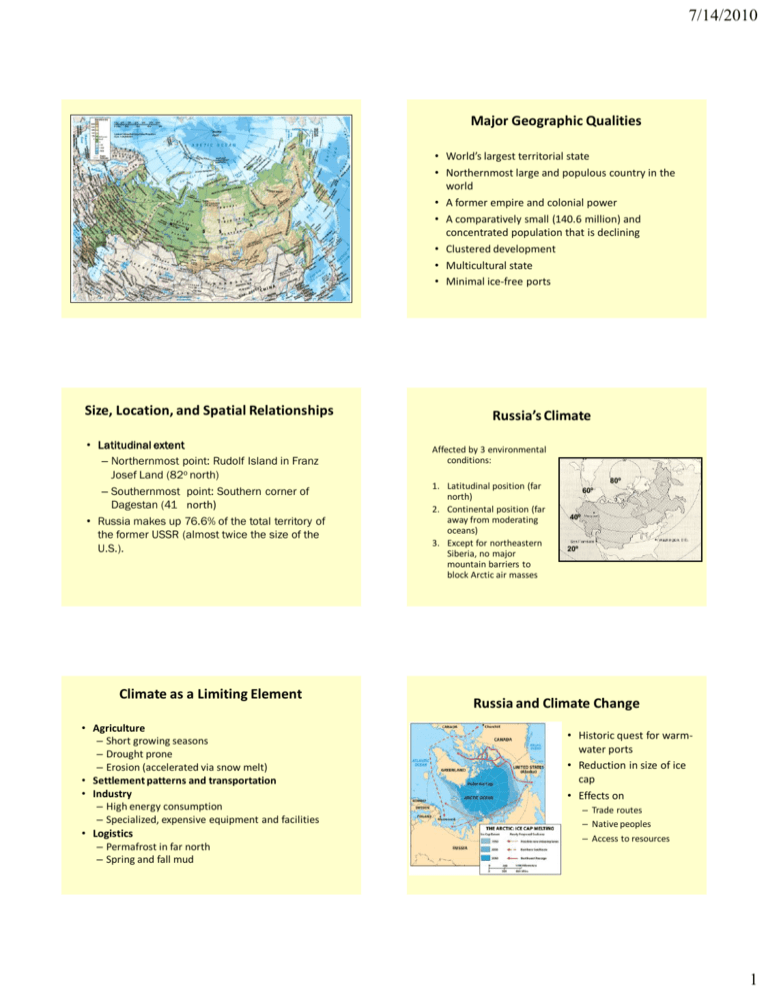
7/14/2010 Major Geographic Qualities • World’s largest territorial state • Northernmost large and populous country in the world • A former empire and colonial power • A comparatively small (140.6 million) and concentrated population that is declining • Clustered development • Multicultural state • Minimal ice-free ports Size, Location, and Spatial Relationships • Latitudinal extent – Northernmost point: Rudolf Island in Franz Josef Land (82o north) – Southernmost point: Southern corner of Dagestan (41 north) • Russia makes up 76.6% of the total territory of the former USSR (almost twice the size of the U.S.). Climate as a Limiting Element • Agriculture – Short growing seasons – Drought prone – Erosion (accelerated via snow melt) • Settlement patterns and transportation • Industry – High energy consumption – Specialized, expensive equipment and facilities • Logistics – Permafrost in far north – Spring and fall mud Russia’s Climate Affected by 3 environmental conditions: 1. Latitudinal position (far north) 2. Continental position (far away from moderating oceans) 3. Except for northeastern Siberia, no major mountain barriers to block Arctic air masses 80º 60º 40º 20º Russia and Climate Change • Historic quest for warmwater ports • Reduction in size of ice cap • Effects on – Trade routes – Native peoples – Access to resources 1 7/14/2010 Physiographic Regions Arctic Geopolitics • Russian Plain – Eastward continuation of North European Lowland – Core area (Moscow Basin) • Ural Mountains – 3,200 kilometers (2,000 miles) long (north-south) – Yield a variety of minerals • West Siberian Plain – World’s largest unbroken lowland – Permafrost in the far north Russian History Physiographic Regions (continued) • Central Siberian Plateau – Sparsely populated – Temperature extremes, permafrost • Yakutsk Basin – Mountainous – High relief Core: Region around Moscow Colonialism, imperialism in search of wealth, power Russification Czar Peter the Great’s forward capital • Eastern Highlands – Ranges, ridges, precipitous valleys, volcanic mountains – Lake Baykal • Central Asian Ranges – Rise above the snow line, – Glaciated • Caucasus Mountains – Extension of the Alpine system Forward Capital Soviet History • Soviet legacy – – – – Revolution (1905-1917) V.I. Lenin (Vladimir Ilyich Ulyanov) Capital: Petrograd to Moscow (1918) Continuation of Russian empire and Russification Capital city positioned in actually or potentially contested territory, usually near an international border, confirming the state’s determination to maintain its presence in the region 2 7/14/2010 Russian Ethnicity Former Soviet Union Command Economy Current Organization • An economy in which the means of production are owned and controlled by the state and in which central planning of the structure and the output prevails • Objectives – Speed industrialization – Collectivize agriculture • Features of the Soviet economy – Production of particular manufactured goods in particular places (but often going against basic economic geography) – Economic interdependence of the republics • Russian Federation (1992) • 89 political units – 21 republics – 11 autonomous regions (Okrugs) – 49 provinces (Oblasts) – 6 territories (Krays) – 2 autonomous federal cities Russia’s Federal Districts Changes in Daily Living • • • • • Revival of religion Failure of the pension system Rise of oligarchs Crime and corruption New freedoms 3 7/14/2010 Population Challenges Regions of the Russian Realm Declining population: Low birth rates Rising death rates Estimated 2050 population: 100 million Oil and Gas Regions Russia’s Core -Central Industrial Area -The Volga Region -The Urals Region Eastern Frontier -Kuznetsk Basin (Kuzbas) -Lake Baykal Area (Baykaliya) Siberia -Vast (larger than continental U.S. but less than 15 million people) -Challenging -Resource potential -Forests expanding 4 7/14/2010 Transcaucasia Far East • Former Soviet republics • Now separate countries -Remote -Pacific Rim frontier? -Primary industry is fishing Georgia -Future trade with Japan? -Significant population decline Armenia Azerbaijan Caucasus •Very mountainous and fragmented •Ethnically very diverse; tensions •2008 Russian invasion into parts of Georgia Chechnya • In support of Russian control – – – – Fighting after independence was granted in 1991 Chechens illegally installed a separatist leader Attacks on Russians Chechen terrorism • Why Chechnya deserves independence – Fought against the Russian imperialists two centuries ago – Soviets rearranged the borders to include nonChechen homeland – Massive persecution during Stalin's reign – 1991 declaration of independence 5
